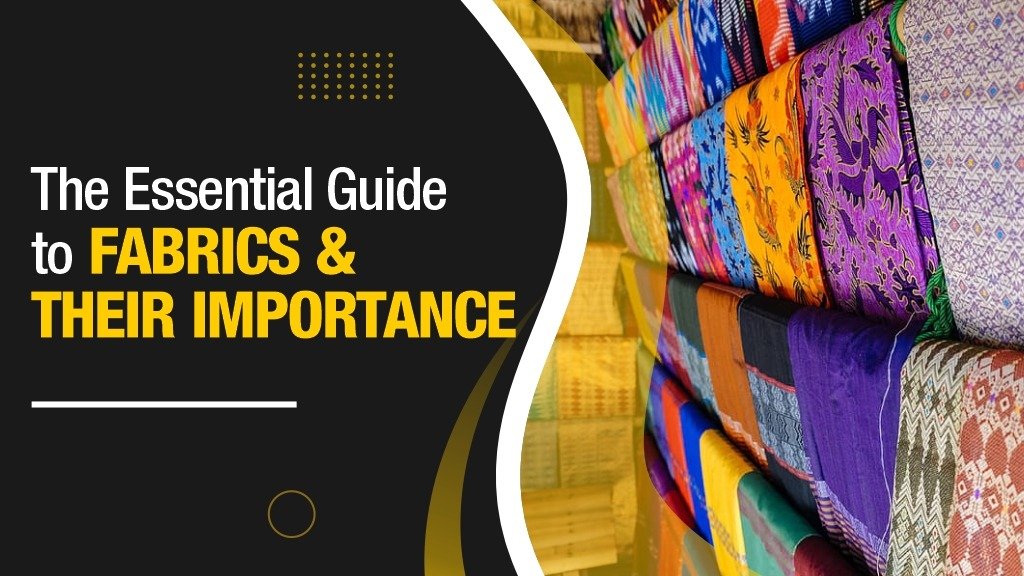In the world of fashion, fabrics are like the essential ingredients in a recipe. They’re what make clothes look good, feel good, and last long. Think of them as the building blocks for every piece of clothing you wear. Whether it’s a soft cotton T-shirt or a silky evening gown, the type of fabric used affects how it looks, how comfortable it is, and how well it holds up over time. Fashion designers pay close attention to fabrics because they play a huge role in their work.
The fabric they choose can make or break a design. It’s not just about making something pretty; it’s also about ensuring it feels good to wear and lasts a long time. That’s why understanding fabrics is super important for designers. It helps them make smart choices that keep their customers happy and their designs looking great.
In this blog, we’ll take a closer look at why fabrics matter so much in fashion. We’ll also explore the different types of fabrics you can find in stores in India. Plus, we’ll talk about why designers need to think about the cost of the fabrics they use. So, whether you’re a fashion enthusiast or a budding designer, understanding fabrics is key to creating clothes that look good, feel good, and last long. Here’s why picking the right fabric matters:
Aesthetic Appeal: Fabric texture, color, and pattern play a pivotal role in defining the visual appeal of a garment. Whether it’s the luxurious sheen of silk or the rustic charm of linen, each fabric imparts a unique character to the design.
Comfort and Wearability: The tactile properties of fabric determine the comfort level and wearability of clothing. Soft, breathable fabrics like cotton and bamboo ensure comfort, especially in warm climates, while durable options like denim withstand everyday wear.
Functionality: Fabrics tailored for specific purposes enhance the functionality of garments. For instance, moisture-wicking fabrics are ideal for activewear, while water-resistant materials suit outdoor apparel.
Sustainability: With increasing awareness about environmental issues, sustainable fabrics are gaining prominence. Materials like organic cotton, bamboo, and Tencel offer eco-friendly alternatives, appealing to conscious consumers.
Types of Fabrics in the Indian Market:
India’s fabric market is a tradition and culture treasure trove, offering an extensive range of materials. Luxurious silks, renowned for their elegance and sheen, stand alongside humble cotton, prized for its comfort and versatility. But the variety doesn’t stop there. Indian markets showcase a plethora of fabrics like vibrant chiffons, durable linens, and intricate brocades, each telling a unique story of craftsmanship and heritage. Whether it’s the regal Banarasi silk or the breezy Kota Doria, these fabrics not only adorn the people but also carry the essence of India’s rich textile legacy, the Indian market offers a diverse array of options:
Silk: Renowned for its elegance and lustrous texture, silk remains a coveted choice for special occasions. Variants like Mulberry silk, Tussar silk, and Muga silk showcase the country’s silk heritage.
Cotton: With its versatility and breathability, cotton is a staple fabric in Indian fashion. It comes in various weaves, including Khadi, Chanderi, and Maheshwari, reflecting regional craftsmanship.
Linen: Known for its lightweight and breathable properties, linen is perfect for summer wear. Indian linen, particularly from states like West Bengal and Andhra Pradesh, is prized for its quality.
Chiffon and Georgette: These lightweight, sheer fabrics are popular choices for sarees and eveningwear, offering fluidity and elegance.
Velvet and Brocade: Rich in texture and often embellished with intricate designs, velvet and brocade fabrics exude luxury, making them ideal for festive attire.
Khadi: Symbolizing self-reliance and sustainability, Khadi holds a special place in Indian textiles. Handspun and handwoven, it represents artisanal craftsmanship and ethical production practices.
Cost Analysis and Why Fashion Designers Should be Mindful:
Understanding the cost of fabrics is vital for fashion designers as it shapes their pricing strategies, profit margins, and competitiveness in the market. By knowing how much fabrics cost, designers can make informed decisions about pricing their products to attract customers while ensuring profitability. Moreover, being knowledgeable about fabric costs allows designers to optimize their production processes and allocate resources effectively, maximizing their returns. In a competitive industry where every penny counts, being well-versed in fabric costs gives designers a strategic advantage, enabling them to create high-quality, affordable fashion that resonates with consumers. Here’s why fashion designers should be well-versed in the cost of fabrics:
- Budget Constraints: Fabric cost directly impacts the overall production budget. Designers can optimize resources and maximize profitability by selecting cost-effective options without compromising quality.
- Pricing Strategy: Understanding fabric costs enables designers to set competitive prices that resonate with target consumers. Balancing quality and affordability is essential for capturing market demand.
- Material Selection: Knowledge of fabric costs empowers designers to make informed choices regarding material selection. They can weigh the benefits of premium fabrics against budget-friendly alternatives, aligning with their brand ethos and target market.
- Cost Efficiency: Efficient utilization of resources, including fabric, is paramount for sustainable business practices. Designers who are mindful of fabric costs can minimize wastage and optimize production efficiency, contributing to long-term viability.
- Consumer Perception: Consumers perceive value based on the quality of materials used in garments. By offering products crafted from high-quality yet cost-effective fabrics, designers can enhance brand reputation and foster customer loyalty.
Fabrics are not just mere elements in fashion, they form the very foundation upon which the entire industry stands. They hold immense power, shaping the way a garment looks, feels, and functions. From the soft embrace of cotton to the luxurious allure of silk, each fabric tells a unique story, reflecting cultural heritage and artisanal mastery.
In the bustling marketplaces of India, this diversity is on full display. Here, fabrics are not just materials; they are embodiments of centuries-old traditions and craftsmanship. From the intricate weaves of Banarasi silk to the vibrant hues of Kalamkari cotton, every fabric speaks volumes about the rich tapestry of Indian culture. For fashion designers, the journey begins with understanding the intrinsic qualities of each fabric. It’s not merely about choosing what looks pretty, but about selecting materials that align with the design’s vision while ensuring comfort, durability, and overall quality. This understanding is essential, as it directly influences the creative process and, ultimately, consumer satisfaction.
However, creativity must be tempered with pragmatism. In a world where resources are finite and budgets are tight, cost analysis becomes paramount. Fashion designers must navigate these constraints, optimizing resource allocation to deliver designs that are not only aesthetically pleasing but also economically viable. By striking a delicate balance between creativity and cost-effectiveness, designers can carve a niche in the fiercely competitive fashion landscape. They can create value-driven designs that resonate with consumers while honoring the profound significance of fabrics in shaping sartorial narratives.
In essence, fabrics are more than just materials; they are vessels of culture, history, and creativity. They are the threads that bind together the intricate tapestry of fashion, weaving stories that transcend time and trends. And in the hands of skilled artisans and visionary designers, they have the power to transform mere cloth into wearable works of art.




This is really very helpful for fashion enthusiasts & will work as a supporting guide.